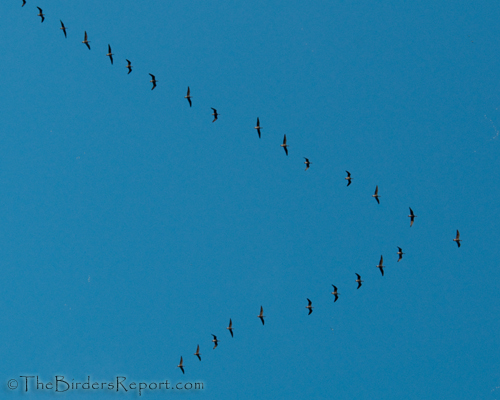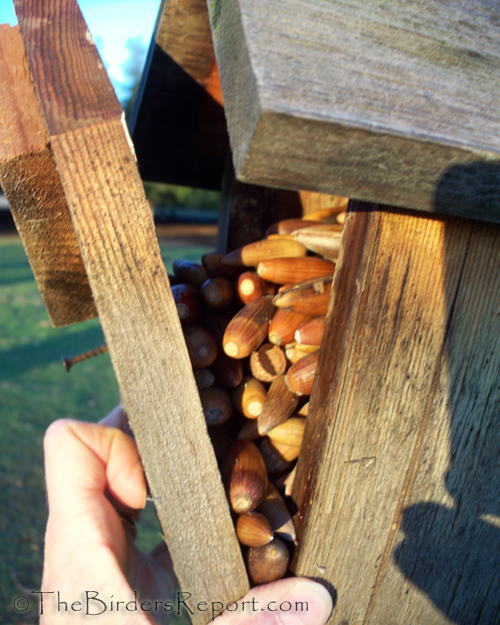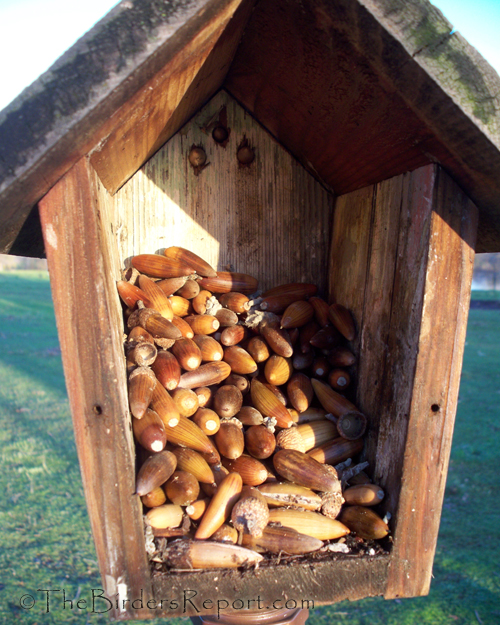 Geese Flying Overhead in “V” Formation photos by Larry Jordan
Geese Flying Overhead in “V” Formation photos by Larry Jordan
As the winter turns to spring and the geese once again begin flying north in those beautiful “V” formations you hear flying overhead, it is time to check your nest boxes once again. Even if you cleaned your birdhouses out in the fall, after all the nesting activity was over, you need to check them all and make sure they are once again ready for the return of all of your cavity nesting birds.

You may find that your birdhouses were used by some bird species during cold winters to stay warm at night. You may even find evidence that mice were using some of your nest boxes for homes. No matter what birds or animals took advantage of the warmth of your birdhouses during the winter, there are important considerations you need to know when you begin cleaning out those nest boxes in the spring.
 I found a couple of nest boxes full of acorns this week
I found a couple of nest boxes full of acorns this week
Position yourself to avoid inhaling any dust from the nest box and wear gloves while cleaning out the boxes. I use a putty knife to remove any old birds nests or wasps nests and put them into a plastic bag with a tie or a zip lock bag in case there are any parasites in the nest box material. Dispose of old nest materials in the trash. Do not dispose of the old nesting materials close to the birdhouse as this may attract predators.
Once you have scraped out the nest box and made sure all of the drain and vent holes are open, you can disinfect birdhouses by spraying them with a 10% bleach solution (one part bleach, nine parts water). If you decide to disinfect your birdhouses, leave them open for 24 hours to allow them to dry before closing them back up. I recommend disinfecting your nest boxes if you have evidence of parasites in any specific boxes. Many times you can simply scrape the insides of the birdhouses and wash them out with a sharp stream of water.
Just as I’m sure you like a clean house, your birds enjoy a clean birdhouse when they arrive in the springtime to bring all of their beautiful color and song to your backyard. Make them welcome by keeping your birdhouses clean before they arrive in the spring and, if you have nesting birds that produce more than one brood per season, clean out the nest boxes after each brood. You can download a complete nest box monitoring guide in PDF format here (3MB).
It’s also very important to clean your bird feeders regularly. Cleaning bird feeders and birdbaths is a crucial practice in preventing the spread of disease between birds. Audubon recommends disinfecting your feeders with the same 10% bleach solution you use for your nest boxes once or twice a month.
When you clean your feeder, get rid of the old seed. Rake or sweep up any uneaten hulls on the ground. Avoid overcrowding by providing more than one feeder for each type of feed you plan on feeding. Move your feeders, if you can, to prevent waste from piling up below the feeders.
Empty water from your birdbath every few days, brush it clean and refill it with fresh water. You will need to do this more often in warm weather. Having a constant source of running water is ideal. Birds can’t resist running water!
Once you clean out all of your nest boxes and bird feeders, you are ready for the Great Backyard Bird Count. The Great Backyard Bird Count is an annual four-day event that engages bird watchers of all ages in counting birds to create a real-time snapshot of where the birds are across the continent and in Hawaii. It takes place from February 12th through the 15th this year.
Anyone can participate, from beginning bird watchers to experts. It takes as little as 15 minutes on one day, or you can count for as long as you like each day of the event. It’s free, fun, and easy—and it helps the birds.









Comments on this entry are closed.
At least your geese know how to fly in formation.
I don’t know if the crazy Cormorants here just don’t do it, or if they are still training 😉
Great tips on the birdhouse!
.-= Nicole´s last blog ..Circling Cormorants =-.
This is helpful Larry as I put up my first nesting box (wood ducks) this fall. I do clean the bird feeders which is really fun in the winter (not) so cleaning a nesting box makes sense. I was really surprised to hear spring type bird song on a couple of warmer days we had before we went back into the big freeze…I can’t wait for spring….Michelle
I love the cache of acorns! Well, as long as no one else is using the house…
Larry: great site, I found it via Google while trying to track some shots of Northern Harriers. My daughter came down this morning and said “there’s an owl on the hill.” It wasn’t an owl, but I am now fairly confident it was a harrier — it sat on the ground, on a hill, in the sun for a good long time (it was freezing outside of Boston today). They live near here, in our neighborhood, and I see them frequently, sometimes in my garden beds even, but i’ve had a tough time ID-ing it… anyway, great site, I just started following you on twitter. Happy birding.
tv
.-= ted´s last blog ..Review: WordCamp Boston, 2010 =-.
I’m with Jason! That birdhouse full of acorns is awesome! What hard work some busy Blue Jay or other bird must have done to collect so many acorns.
…Can’t believe it is time to start thinking about Spring already. 🙂
.-= Amber Coakley´s last blog ..I Kinda Forgot to Mention… =-.
@Nicole thanks. I think Cormorants only fly in “V” or echelon formation at high altitudes over long distances
@Michelle I really hope you get some Wood Ducks to nest in your box. How exciting to have those beauties breeding on your property
@Jason yes, as long as they don’t expect to find them there in the Spring 😉
@Ted thanks for the visit and the follow! The Northern Harrier is pretty easy to ID by the white rump that always shows
@Amber yup, spring is almost here. I’m not sure if the acorn stasher was an Acorn Woodpecker or a Gray Squirrel